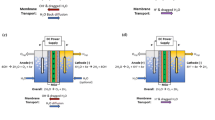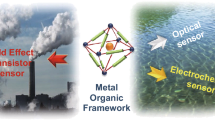Summary
The performance of synthetic-polymer membrane-electrodes for cation sensing is investigated by obtaining E versus pM graphs and E versus time curves of the same membrane type under different treatments or of membranes constructed by modified procedures. The slopes of E versus pM curves for the salts of monovalent cations show different values for the same membrane type as well as for the different membrane types and are found within the range of 43 to 57 mV per pM. The response time of the membrane is found to be slower when the membranes are plastic phase deficient. Generally, the detection limit is only slightly dependent on the composition of the membrane and the best value is obtained with the polished membranes which is close to the value of pM=5 while for the other membranes the values are within the range of pM 4 to 5. The range of linearity is also slightly dependent on the method of membrane construction and in general is shorter when the membranes are plastic phase deficient. The selectivity coefficients are found to depend significantly on the method of construction of the membrane but in general the selectivity of all the membranes studied in this report is poor. The asymmetry potential is found to be related to an ion exchange process and is developed slowly in 5A-type membranes. However, when the value of asymmetry potential is high, a longer time is needed to reach the final value of e.m.f. in measurements among different concentrations of the same metal ion and much longer is needed where there is switching of measurement from a monovalent cation to a divalent cation.
Similar content being viewed by others
References
Meyer KH, Sievers JF (1936) Helv Chim Acta 19:649,665, 987
Teorell T (1935) Proc Soc Exp Biol Med 33:282–285. (1937) Trans Faraday Soc 33:1054–1057
Marshall CE (1939) J Phys Chem 43:1155–1164
Marshall CE, et al. (1941) J Amer Chem Soc 63:1911–1916; (1942) 64:1814–1819; (1948) 70:1297–1302; 1302–1305
Wyllie MRJ, Patnode HW (1950) J Phys Chem 54:204–227
Barrer RM, James SD (1960) J Phys Chem 64:417–427
Johansson G, Falth L, Risinger L (1980) Hung Sci Inst 49:47–51; (1980) Anal Chim Acta 119:25–32
Demertzis MA, Evmiridis NP (1986) J Chem Soc Faraday Trans 1 119:3647–3655
Drummond D, De Jonge A, Rees LVC (1983) J Phys Chem 87:1967–1971
Rolison DR (1990) Chem Rev 90:867–878
Author information
Authors and Affiliations
Rights and permissions
About this article
Cite this article
Evmiridis, N.P., Demertzis, M.A. & Vlessidis, A.G. Effect of treatment of synthetic zeolite-polymer membranes on their electrochemical-potential response characteristics. Fresenius J Anal Chem 340, 145–152 (1991). https://doi.org/10.1007/BF00324470
Received:
Issue Date:
DOI: https://doi.org/10.1007/BF00324470




